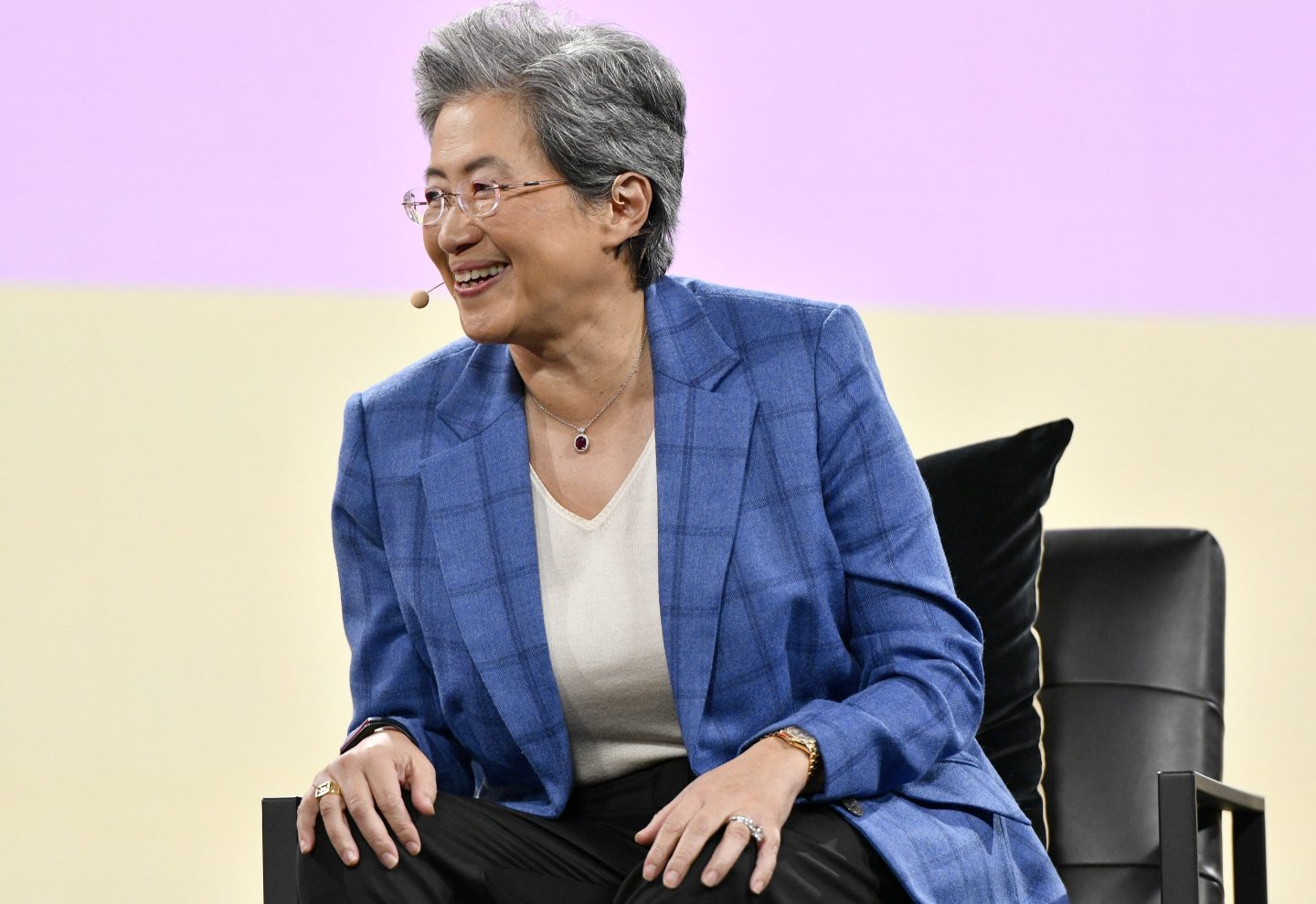Lisa Su has already had a very successful tenure at the home of the fabled (but these days fabless) chip giant AMD. In the past nine years, she’s rescued the company and ensured its products are found in countless data centers, not to mention its previous staple of the desktop PC. And now, despite rival Nvidia holding something in the region of 85% market share, she intends to ensure that AMD makes the most out of the AI explosion.
I spoke to Su for an article that will appear in Fortune’s October/November magazine, and that just went up on Fortune.com. The interesting thing about her AI-processor-related ambitions is that she doesn’t merely see AMD gaining a foothold by virtue of Nvidia being unable to satisfy the market’s rampant demand for AI processors—though that’s an obvious opportunity that AMD won’t let pass by.
Su thinks AMD’s rival processors, as currently exemplified by the MI300 line, can make the company “the industry leader for inference solutions”—that is, AI deployments that take already-trained models and use them to infer stuff from the fresh data that’s thrown at them.
That’s a pretty tall order when Nvidia is also trying to seize the inference market, and analysts are currently predicting that AMD would do very nicely from gaining something like 30% market share. But if AMD really is going to become the industry leader, it’s going to need to change the well-founded perception that it’s far easier to build AI models on Nvidia than on AMD, owing to Nvidia’s superior software offerings.
One AI company that thinks AMD is already there is Lamini, which provides a platform to help enterprises build their own large-language models. Last week Lamini revealed that it’s been running LLMs on AMD’s graphics processors for a year now, and said AMD’s ROCm software had now achieved “parity” with Nvidia’s CUDA. “AMD has been putting hundreds of engineers behind their general-purpose AI initiative,” Lamini cofounder Gregory Diamos, who used to be a CUDA architect at Nvidia, told me as I was researching my article.
Microsoft chief technology officer Kevin Scott also talked up AMD’s GPU chips at the Code conference last week, predicting that they would become “more and more important to the marketplace in the coming years”—comments that bumped AMD’s shares up nearly 5% the next day.
Meanwhile, Nvidia’s dominant market share is also drawing scrutiny from antitrust authorities in France, who reportedly raided its offices last week.
So maybe Su has reason to be so bullish. You can read my piece on her here. More news below.
Want to send thoughts or suggestions to Data Sheet? Drop a line here.
David Meyer
NEWSWORTHY
Indonesia bans social media e-commerce. TikTok has fallen in line with a new law in Indonesia that bans e-commerce activity on social media platforms. As Nikkei reports, the law was enacted last week as a protectionist measure for the benefit of traditional, offline businesses—but its enforcement comes as a blow to those who have been finding a living selling things on platforms such as TikTok.
Anthropic funding frenzy. Barely a week after Amazon pledged to invest up to $4 billion in Anthropic, The Information reports that Google and others are planning to participate in a new, $2-billion-plus funding round for the AI-world darling. Google already bought a stake of around 10% last year. These investments are partly plays for cloud business: As things currently stand, Anthropic has now committed to making Google its “preferred” cloud provider for non-mission-critical workloads, while Amazon’s greater investment makes it the “primary” provider overall.
Nessie identified. Mystery solved. The Wall Street Journal reports that Amazon’s Project Nessie algorithm—alluded to in redacted parts of the FTC’s antitrust suit against the company—was designed to help Amazon boost its profits by tentatively raising prices for items, then dropping them again if competing retailers didn’t follow suit. Amazon claims Nessie was only instituted “to try to stop our price matching from resulting in unusual outcomes where prices became so low that they were unsustainable…but didn’t work as intended, so we scrapped it several years ago.”
SIGNIFICANT FIGURES
2%
—The percentage of British AI companies receiving funding in the past decade that were founded by women, according to a report from the government-funded Alan Turing Institute. Erin Young, a research fellow there, told the Guardian, “There is an urgent need for women and minorities to have equal access in the tech and venture space.”
IN CASE YOU MISSED IT
Meta’s AI characters played by celebrities like Charli D’Amelio and Tom Brady are dissing the products and brand sponsors they work with in real life, by Alexandra Sternlicht
YouTube’s biggest star MrBeast seemed to launch the ‘world’s largest iPhone giveaway’—but it turns out that, like Tom Hanks, he was the face of an AI scam, by Eleanor Pringle
IBM’s CEO says ‘the first thing you can automate is a repetitive, white-collar job,’ but he’s not cutting workers: ‘I’ll get more,’ by Paolo Confino
Lyft’s CEO has apologized for its ‘awful’ response after a driver accidentally drove away with a customer’s cat, by Eleanor Pringle
ChatGPT plugs into the internet’s real-time data firehose—again, by Sage Lazzaro
Commerce Secretary Gina Raimondo on her working group with China: ‘Hopefully the baby steps lead to bigger steps,’ by Leo Schwartz
BEFORE YOU GO
Making phones in Europe. HMD Global, the company that wields the Nokia brand in the smartphone market these days, said back in February that it would bring some of its manufacturing to Europe. Now it’s actually happened: HMD yesterday launched a made-in-Hungary version of its rugged XR21 device, pitched at security-conscious enterprise customers.
As Reuters reports, this is Europe’s first large-scale smartphone-making play, and it comes at a time when companies and other customers are increasingly concerned about the national security implications of relying on Chinese manufacturing.
This is the web version of Data Sheet, a daily newsletter on the business of tech. Sign up to get it delivered free to your inbox.












